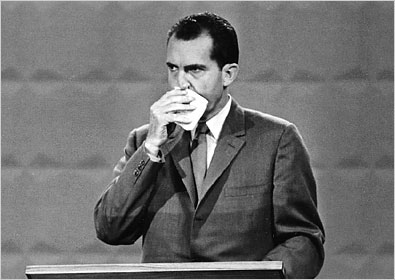How To Dress For Television And Speeches
This is the first in a week-long series that will teach you how to dress, apply makeup, and wear your hair for media interviews and public appearances. You can see the complete series here.
If you’re a spokesperson for a company or organization long enough, you can expect to appear on television, in a video, or in front of a live audience at some point. And there’s no escaping the fact that your physical appearance is a critical part of your message in those settings.
“People do judge you during the first few seconds,” author Lillian Brown notes in Your Public Best: The Complete Personal Appearance and Media Training Guide. “If your appearance is attractive, you can get an audience on your side before you have even said a word.”
For this week’s blog posts, we consulted experts who have helped Hollywood stars, First Ladies and scores of other high-profile personalities look good on television.

Richard Nixon Sweating in 1960 Debate
We’ll concentrate on television, because that’s the most demanding medium – but most of the general concepts also translate to videos and public speaking.
What makes television special? The bright lights and camera lenses render things differently from the way we perceive them in real life. The consequences can be devastating: few can recall what Richard Nixon said in the first televised presidential debate with John F. Kennedy, but plenty of people remember that Nixon (who refused to wear makeup) looked pallid and ill-shaven and was visibly sweating, while Kennedy looked poised and comfortable. What’s especially striking is that people who only heard their words on the radio thought Nixon had won; those who watched the men on television reached the opposite conclusion.
Most television appearances today last just a few minutes (or mere seconds), so you don’t want your physical appearance to distract viewers. But keep a couple of things in mind as you read the guidelines over the next few days:
1. Congruence With Brand: It’s crucial that your look is congruent with your brand. If you’re representing a cutting-edge fashion house, don’t dress like a scientist (unless it’s the latest hipster look!), and vice versa.
2. Look Like Yourself: You should end up looking like yourself, with minor adjustments. Only if you’re comfortable with your appearance will you be able to successfully put it out of your mind and radiate the self-confidence that will underscore your message.
In general, your wardrobe, makeup and hair-do should be simple and understated, so they don’t distract from the most expressive part of your face – your eyes – or from your words. In other words, avoid the Tammy Faye Bakker look if you want to be taken seriously.
Tomorrow we’ll cover attire; Wednesday will be devoted to make-up; Thursday to hair; and Friday to hands, accessories and special considerations for high-definition cameras.
Many of these tips were used with permission from Your Public Best: The Complete Personal Appearance and Media Training Guide by Lillian Brown. Published by Newmarket Press.
Hi Luba,
Thanks for doing this series while Brad is enjoying his honeymoon. It seems like it’s going to be very informative.
I had a question regarding “Congruence With Brand”, and maybe you could touch upon it in the comments or in your next blog post.
How do you adjust your appearance when you are talking to a group that is outside of your typical industry arena? So using your example, obviously a scientist will dress in a suit and tie when presenting his findings at a conference of his peers. But how should he dress if he’s going to the local elementary school to give out a top prize at a science fair?
Or say I have a client who works in Silicon Valley and wears the standard jeans and t-shirt. The attire works to give a speech at a tech conference, but how should he dress when talking on CNBC and his comments are directed towards wall street?
I know that there probably isn’t any clear cut rule, but any suggestions or guidelines that you can offer would be greatly appreciated.
Hi Thomas,
Thanks for your question!
My advice: A brand’s general tone should always be maintained, while allowing for some contextual variations.
It might be useful to think of this in personal terms. Let’s say you have a friend who is very serious and modest. You may see him wearing a business suit on his way to the office and a bathing suit at the pool. No incongruence in that. However, wouldn’t it seem out of character if his business suit was really flashy and/or his swimsuit was a tight little Speedo?
So a scientist representing a conservative corporation would dress differently than a scientist representing a laboratory with a casual culture, regardless of the venue. (One might wear a long-sleeved shirt and tie while presenting a science prize to elementary school students; the other might wear shorts).
And if a company has a young and hip public image, its employees can even show up on CNBC in a T-shirt (as Facebook CEO Mark Zuckerberg has done). On the other hand, what if the same employee were speaking about this country’s international trade competitiveness at the White House? A three-piece suit may still not be necessary, but a lively shirt and tie could work.
Hope that helps, and I hope you find the rest of the series useful.
— Luba Vangelova
Thanks for your great answer.
The series that you’re writing is offering some great tips.
Thanks for your great ideas and tips.